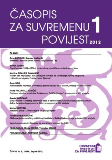Povijesni identitet umjetnika Schiavona u kritičkoj fortuni prve polovine XX. stoljeća
THE HISTORICAL IDENTITY OF THE “SCHIAVONA” ARTISTS IN FORTUNA CRITICA DURING THE FIRST HALF OF THE 20TH CENTURY
Author(s): Ivana Prijatelj PavičićSubject(s): History
Published by: Hrvatski institut za povijest
Keywords: artists referred to as Schiavoni; the Treaty of London; the Treaty of Rapallo; Adolfo Venturi; Alessandro Dudan; Artur Schneider; Medulić Society; Giuseppe Praga; Ljubo Karaman; Ivo Tartalja; irredentism; Adriatic mentality
Summary/Abstract: This work aims to explore interpretations of the historical, symbolic, regional, and national artistic identities in the reception of the most well-known artist-emigrants originating from the eastern Adriatic shore who in Croatian art history are referred to and studied by the common term given to the protonational community to which they belonged – that is the Schiavoni/Dalmati artists, and especially the echoes of national ideologies and political activity in Fortuna critica in the period from the beginning of the 20th century until 1945. The Fortuna critica of the artists referred to as Schiavoni/Dalmati during the first half of the 20th century is examined through the methodology of aesthetic reception and contemporary art historical criticism. The author shows to what extent the reception of the Schiavoni/Dalmati artists was influenced by various political ideas, national ideologies, and cultural nationalism. In particular, she discusses how this relates to the ideologies of Italian irredentists as well as Yugoslavian and Italian cultural politics in the interwar era.
Journal: Časopis za suvremenu povijest
- Issue Year: 44/2012
- Issue No: 1
- Page Range: 77-92
- Page Count: 16
- Language: Croatian

